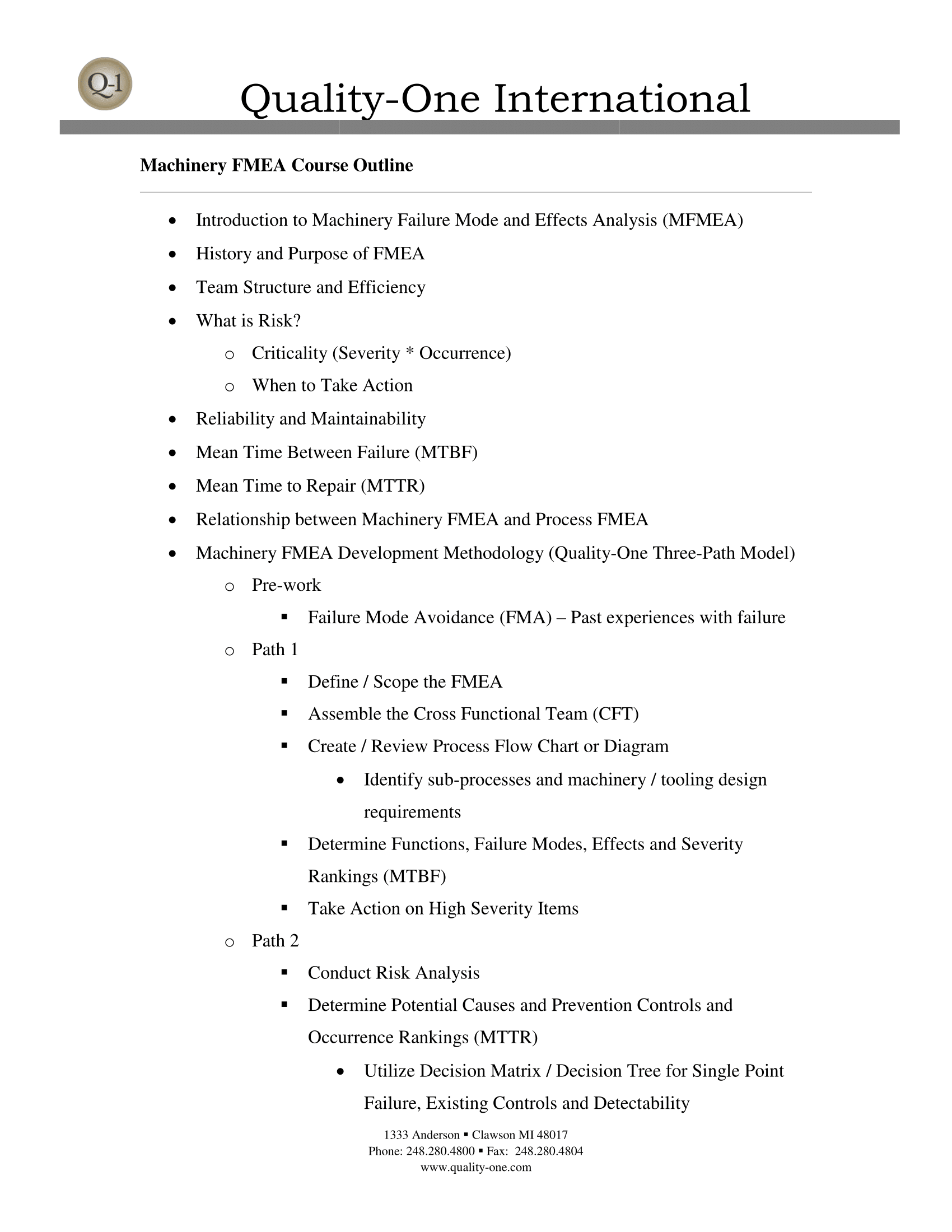Machinery FMEA
– Machinery Failure Mode & Effects Analysis –

Introduction to Machinery Failure Mode and Effects Analysis (MFMEA)
The efficiency of an assembly line depends on how reliable the tooling and equipment was designed and built. Assume you have an assembly line with 10 machines. Each machine can function at a 90% uptime rate. Each machine may fail at random times, or mutually exclusive from one another. The resulting reliability of the line with 10 machines at 0.9 (90%) reliability each is 35%. This means that some portion of the assembly line could be down 65% of the time. Expand this principle to complex assembly operations where many more than 10 individual machines are needed to produce products. The reliability of the line would be much worse. A critical piece of equipment would fail nearly every day. As you can see, this is no way to run a profitable business.
Machinery Failure Mode and Effects Analysis (MFMEA) will help identify weaknesses in the reliability of the critical equipment and tooling during machinery, equipment or tooling design. Improving the reliability of the components of the machine has the net effect of higher reliability. When reliability cannot be improved further, the ability to replace worn parts in an expedited way is considered. An attempt to anticipate failure and add design features which measure the amount of wear or predict when maintenance will be necessary is also beneficial. All of these items and more are addressed and discovered in a Machinery FMEA.
What is Machinery Failure Mode and Effects Analysis (MFMEA)
Machinery FMEA is a methodical approach used for identifying risks associated with machinery and equipment failure. The purpose of the MFMEA is to increase reliability of the machinery, reduce time to repair and add prevention techniques, such as diagnostics. MFMEA is an integral part of Total Predictive Maintenance (TPM).
The Machinery FMEA initially identifies the machine functions, speed of operation and expected productivity or throughput. Reliability performance may also be stated for the Equipment or Tooling. Failure Modes and their effects are listed. If there are design inputs or special characteristics, the effect on end users is also included. A Severity ranking is the determined for each effect. Next, detailed causes and their mechanisms, including physics of failure, are identified. A high probability, due to past failure or lack of evidence, will drive an action to prevent or reduce the cause’s impact on the failure mode. The detection ranking determines the effectiveness of the machinery and diagnostics controls. A poor detection ranking will drive an action to improve the ability to detect a cause of failure and warn of impending failure. The MFMEA will also track improvements through reductions in Risk Priority Number (RPN). By comparing the before and after RPN, a history of risk mitigation is kept for future review.
Why Perform Machinery Failure Mode and Effects Analysis (MFMEA)
Risk is the substitute for failure on new processes. It is desirable to identify risks for each machine or tool as early as possible. The main goal is to identify potential risk prior to machinery, equipment or tooling design. Mitigation of the identified risk is reviewed during design reviews of the equipment, at stages of the build and at initial trail runs at the manufacturing facility. This review occurs prior to shipping equipment to the user facilities. Final approval of the machinery, equipment and tooling often occurs at the first production trial runs at the customer’s production facility.
Risks are identified on new technology and processes, which left unattended, could result in failure. The Machinery FMEA is applied when:
- A customer requests evidence to support reliability targets for the machine
- A new technology or process is introduced
- A current process with modifications made to tooling / equipment due to Kaizen, Lean or Cost of Quality projects
- A current machine is placed in a new environment or different location
How to Perform Machinery Failure Mode and Effects Analysis (MFMEA)
The Quality-One best practice Three-Path Model can be applied to all FMEA types. Machinery FMEA has five primary sections. Each section has a distinct purpose and a different focus. The sections are reviewed at different times within the project timeline, not all at once. The MFMEA is completed in the following sequence:
MFMEA Section 1 (Quality-One Path 1)
Equipment / Machinery / Tooling or Process Name / Function
This column permits the engineer to describe the technology that is being analyzed. The function can be a manufacturing operation provided by a piece of equipment. The function is stated as a Verb-Noun and describes what the machinery, equipment or process operation does. There may be multiple functions for any one machine or piece of equipment.
Requirement
The requirement / measurement of the function and / or the speed or throughput expected are described in this column. The requirements are either provided by a drawing or a list of Special Characteristics. A form of Quality Function Deployment (QFD), called a Characteristics Matrix, may be used to link the Special Characteristics to process operations. The requirement must be measurable and should have associated test and inspection methods. The first opportunity for recommended action may be to investigate and clarify the requirements with the design engineer.
Failure Mode
The failure mode is also known as the anti-function and is a statement of the requirements not being met. There are five varieties of failure modes:
- Full Failure
- Partial Failure
- Intermittent Failure
- Degraded Failure
- Unintentional Failure
Effects of Failure
The effects of failure are focused on impacts on the process, subsequent operations and / or potential customer impact. Many effects may be possible, however all effects should appear in the same cell next to the corresponding failure mode.
Severity
The severity of each effect is selected. The severity ranking is typically between 1 through 10. Typical MFMEA Severity guidelines are as follows:
- 1: Process parameter variability within specification limits; adjustment or other process controls can be taken during normal maintenance
- 2: Process parameter variability not within specification limits; adjustment or other process controls need to be taken during production; no downtime / no production of defective parts
- 3: Downtime of up to 10 minutes, but no production of defective parts
- 4: Downtime of 10 to 30 minutes, but no production of defective parts
- 5: Downtime between 30 minutes and 1 hour or the production of defective parts for up to 1 hour
- 6: Downtime of 1 to 4 hours or the production of defective parts for 1 to 2 hours
- 7: Downtime between 4 and 8 hours or the production of defective parts for 2 to 4 hours
- 8: Downtime greater than 8 hours or the production of defective parts for greater than 4 hours
- 9-10: Regulatory and / or Safety implications
The highest severity is chosen from the many potential effects and placed in the Severity Column on the MFMEA form. Actions may be identified which can change the design direction on any failure mode where the resulting effect is ranked 9 or 10. If a recommended action is identified, it is placed in the Recommended Actions column of the MFMEA form.
Classification
Classification categorizes the type of characteristics based on potential risk. These special characteristics typically require additional work, design / process error proofing, process variation reduction (Cpk) or Mistake Proofing. This column designates where the characteristics may be identified for Machinery FMEA Collaboration with the Process FMEA or Control Plan.
MFMEA Section 2 (Quality-One Path 2)
Potential Causes / Mechanisms of Failure
Causes are defined for the each failure mode and should be determined based on their impact on the failure mode. Causes are brainstormed and should focus on the following: Material, Machine, Measurement and Mother Earth (Environment). Use of words like bad, poor, defective and failed should be avoided as they do not define the cause with enough detail to make risk calculations for mitigation.
Current Machinery Controls Prevention
The prevention strategy defined by the machinery and equipment approach uses standard parts that easy to acquire, robust parts when access is limited and diagnostics which will not permit failure. Proven prevention controls will lower the occurrence or probability of the cause. The stronger the prevention control, the more likely the equipment or tooling engineer was aware of the potential cause. The use of verified standards and past proven technology being reused (similar stresses applications) is highly desired.
Occurrence
The occurrence ranking is an estimate based on known data or lack of it. The Occurrence can be related to known / similar technology or new process, equipment or tooling technology and is related to Mean Time Between Failures (MTBF). Typical MFMEA Occurrence guidelines are as follows:
- 1: MTBF greater than 10,000 hours
- 2: MTBF from 6,001 to 10,000 hours
- 3: MTBF from 3,001 to 6,000 hours
- 4: MTBF from 2,001 to 3,000 hours
- 5: MTBF from 1,001 to 2,000 hours
- 6: MTBF from 401 to 1,000 hours
- 7: Intermittent operation resulting in 1 failure in 10,000 production pieces or MTBF of 101 to 400 hours
- 8: Intermittent operation resulting in 1 failure in 100 production pieces or MTBF of 11 to 100 hours
- 9: Intermittent operation resulting in 1 failure in 100 production pieces or MTBF of 2 to 10 hours
- 10: Intermittent operation resulting in 1 failure in 10 production pieces or MTBF of less than 1 hour
Actions may be directed against causes of a failure mode which have a high occurrence. Special attention must be placed on items with Severity 9 or 10. Failure modes with high severity and occurrence combinations must have actions in place that assure due diligence has been demonstrated.
MFMEA Section 3 (Quality-One Path 3)
Current Machinery Controls Detection
The activities conducted to verify the machine can identify when or if it may fail, are placed in the Current Machinery Controls Detection Column. A few examples of detection controls are:
- Error proofing devices (cannot make nonconforming product)
- Mistake proofing devices (cannot pass nonconforming product)
- Sensors for proximity, presence or wear
- Alarms for unstable machine parameters
- Visual inspection
Detection Rankings
Detection Rankings are given to each detection method based on the type of detection control selected. There is often more than one detection control per cause / failure mode combination. Best practice is to list all controls in one cell and apply the detection ranking for each. The lowest detection ranking is placed in the detection column. Typical MFMEA Detection guidelines are as follows:
- 1: Design / equipment control will almost certainly detect a potential cause / mechanism and subsequent failure mode
- 2: Very high chance the design / equipment control will detect a potential cause / mechanism and subsequent failure mode
- 3: High chance the design / equipment control will detect a potential cause / mechanism and subsequent failure mode
- 4: Moderately high chance the design / equipment control will detect a potential cause / mechanism and subsequent failure mode
- 5: Moderate chance the design / equipment control will detect a potential cause / mechanism and subsequent failure mode
- 6: Low chance the design / equipment control will detect a potential cause / mechanism and subsequent failure mode
- 7: Very low chance the design / equipment control will detect a potential cause / mechanism and subsequent failure mode
- 8: Remote chance the design / equipment control will detect a potential cause / mechanism and subsequent failure mode
- 9: Very Remote chance the design / equipment control will detect a potential cause / mechanism and subsequent failure mode
- 10: Design / equipment control will not and / or cannot detect a potential cause / mechanism and subsequent failure mode or there is no design / equipment control
Actions may be required to improve the current detection controls. The improvement will address the weakness in the machine evaluation strategy. The actions are placed in the Recommended Actions column.
MFMEA Section 4
Risk Priority Number (RPN)
The Risk Priority Number (RPN) is the product of the previously selected rankings: Severity, Occurrence and Detection. RPN thresholds are not permitted in action determination. RPN thresholds should not be assigned due to two reasons:
- Relative Risk is not always represented by the RPN value
- Poor behavior by the MFMEA team trying to get below the specified RPN thresholds
- This behavior does not address or improve risk
Recommended Actions
The recommended actions column is the location on the Machinery FMEA form that all potential actions / improvements are placed. Completed actions are the purpose of the MFMEA. Actions are directed against one of the previously assigned rankings. The objectives are as follows:
- Eliminate all Failure Mode with a severity ranking of 9 or 10
- Lower occurrence rankings on potentials causes
- Lower detection ranking on tests / evaluation techniques
Responsibility and Target Completion Date
Here, the name of the individual responsible and the date the action will be completed is documented. A milestone name can be used in place of a specific date if a project timeline exists and shows the linkage between date and milestones.
MFMEA Section 5
Actions Taken and Completion Date
The Machinery FMEA will result in actions which bring higher risks items to an acceptable level of risk. Action results should be documented for each action taken. If the action was unsuccessful, another action should be determined. It is important to note that acceptable risk is desirable and mitigation of high risk to lower risk is the primary goal.
Re-Rank RPN
After actions have been taken, the new (re-ranked) RPN should be compared with the original RPN. A reduction in RPN is the main objective in this column. As mentioned above, if the risk is still too high after actions have been taken, a new action must be developed. This is repeated each time until an acceptable level of risk has been obtained.
Machinery Failure Mode and Effects Analysis (MFMEA) Services
Machinery FMEA Services from Quality-One include MFMEA Consulting, MFMEA Training and MFMEA Support, which may include Facilitation, Auditing or Contract Services. Our experienced team of highly trained professionals will provide a customized approach for developing your people and processes based on your unique MFMEA needs. Whether you need Consulting to assist with the development of your MFMEA process, Training to help understand and drive improvement or hands-on Project Support for building and implementing your MFMEA process, Quality-One can support you! By utilizing our experienced team of Subject Matter Experts (SME), Quality-One can help you promote the value of Machinery FMEA in your organization.
Learn More About Machinery Failure Mode and Effects Analysis (MFMEA)
Quality-One offers Quality and Reliability Support for Product and Process Development through Consulting, Training and Project Support. Quality-One provides Knowledge, Guidance and Direction in Quality and Reliability activities, tailored to your unique wants, needs and desires. Let us help you Discover the Value of MFMEA Consulting, MFMEA Training or MFMEA Project Support.

